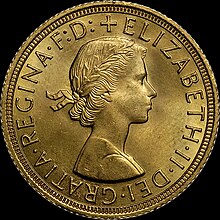
Back سوفرن (عملة بريطانية) Arabic Саверэн Byelorussian Суверен (монета) Bulgarian Sovereign German Orsuvereno Esperanto Soberano (moneda británica) Spanish Souverain (pièce en or) French Soberano (moeda) Galician סובריין HE Sovereign (koin Britania) ID
United Kingdom | |
| Value | £1 |
|---|---|
| Mass | 7.98805 g |
| Diameter | 22.0 mm |
| Thickness | 1.52 mm |
| Edge | Milled (some not intended for circulation have plain edge) |
| Composition | .917 gold, .083 copper or other metals |
| Gold | 0.2354 troy oz |
| Years of minting | 1817–present |
| Mint marks | Various. Found on reverse on exergue between design and date for Saint George and the Dragon sovereigns, and under the wreath for shield back sovereigns, or below bust on obverse on earlier Australian issues. |
| Obverse | |
 | |
| Design | The British monarch currently depicted on the coinage (Elizabeth II depicted here) |
| Reverse | |
 | |
| Design | Saint George and the Dragon |
| Designer | Benedetto Pistrucci |
| Design date | 1817 |
The sovereign is a British gold coin with a nominal value of one pound sterling (£1) and contains 0.2354 troy oz of pure gold. Struck since 1817, it was originally a circulating coin that was accepted in Britain and elsewhere in the world; it is now a bullion coin and is sometimes mounted in jewellery. In addition, circulation strikes and proof examples are often collected for their numismatic value. In most recent years, it has borne the design of Saint George and the Dragon on the reverse; the initials (B P) of the designer, Benedetto Pistrucci, are visible to the right of the date.
The coin was named after the English gold sovereign, which was last minted about 1603, and originated as part of the Great Recoinage of 1816. Many in Parliament believed a one-pound coin should be issued rather than the 21-shilling guinea that was struck until that time. The Master of the Mint, William Wellesley Pole had Pistrucci design the new coin; his depiction was also used for other gold coins. Originally, the coin was unpopular because the public preferred the convenience of banknotes but paper currency of value £1 was soon limited by law. With that competition gone, the sovereign became a popular circulating coin, and was used in international trade and overseas, being trusted as a coin containing a known quantity of gold.
The British government promoted the use of the sovereign as an aid to international trade, and the Royal Mint took steps to see lightweight gold coins withdrawn from circulation. From the 1850s until 1932, the sovereign was also struck at colonial mints, initially in Australia and later in Canada, South Africa and India—they have again been struck in India for the local market since 2013, in addition to the production in Britain by the Royal Mint. The sovereigns issued in Australia initially carried a unique local design but by 1887, all new sovereigns bore Pistrucci's George and Dragon design. Strikings there were so large that by 1900, about forty per cent of the sovereigns in Britain had been minted in Australia.
With the start of the First World War in 1914, the sovereign vanished from circulation in Britain; it was replaced by paper money and did not return after the war, though issues at colonial mints continued until 1932. While it faded out of usage in Britain, the sovereign was still used in the Middle East and demand rose in the 1950s, to which the Royal Mint eventually responded by striking new sovereigns in 1957. Since then, it has been struck both as a bullion coin and beginning in 1979 for collectors. Although the sovereign is no longer in circulation, it – along with the half sovereign, double sovereign and quintuple sovereign – is still legal tender in the United Kingdom, having survived the decimalisation of the pound in 1971.